Probing three-dimensional electronic structures and
Fermi surfaces in a strongly correlated material by hν-dependent high-energy angle-resolved photoemission (ARPES)
(Collaborating with Dr. T. Muro in
SPring-8 and Prof. Y. Onuki in Osaka University)
Phys. Rev. Lett. vol. 98, 036405 (2007).
We have developed a new technique for probing bulk three-dimensional electronic structures and Fermi surfaces by using hν-dependent high-energy soft x-ray angle-resolve photoemission, which has been applied for a strongly correlated ferromagnet CeRu2Ge2 in the paramagnetic phase at a "high" temperature of 20 K.
A clear difference of the Fermi surface topology from either band-structure calculation or
de Haas-van Alphen results in the ferromagnetic phase is observed and interpreted by considering the difference of the 4f contribution to the Fermi surfaces in the paramegnetic phase.
Introduction
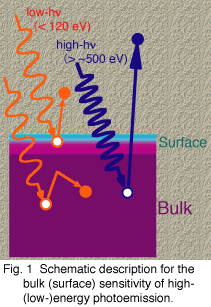 Clarification of electronic structures in crystalline solids is fundamental to understand their physical properties in the field of condensed matter physics and materials science. Especially, the characters and shapes of the Fermi surfaces (momentum distribution of electrons with the highest energy in a metal) are responsible for many intriguing phenomena such as high-temperature superconductivity, metal-insulator transitions, magnetic ordering and heavy Fermion behavior.
Clarification of electronic structures in crystalline solids is fundamental to understand their physical properties in the field of condensed matter physics and materials science. Especially, the characters and shapes of the Fermi surfaces (momentum distribution of electrons with the highest energy in a metal) are responsible for many intriguing phenomena such as high-temperature superconductivity, metal-insulator transitions, magnetic ordering and heavy Fermion behavior. 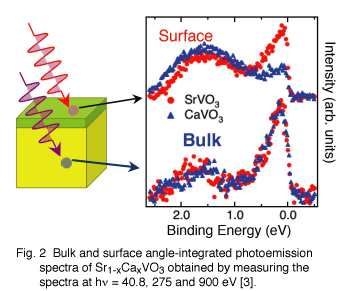 Angle-resolved photoemission (ARPES) is known as a powerful tool to simultaneously detect the electronic dispersions (relations between the electron momentum and energy, namely, electronic structures) and the Fermi surfaces [1]. However, conventional low-excitation energy (hν ≲ 120 eV) ARPES mainly reflects the surface electronic states, which are often noticeably deviated from the bulk states for strongly correlated materials. Since the bulk electronic structures are responsible for the physical properties in solids, a technique for probing the bulk electronic structures is very important for studying solids. In order to overcome the surface sensitivity, high-excitation energy photoemission is promising due to the longer photoelectron escape depth [2] as shown in Fig. 1. Indeed, we have so far measured surface-sensitive low-energy and bulk-sensitive high-energy angle-integrated photoemission spectra reflecting the electron density of states in the solids for strongly correlated transition metal oxides Sr1-xCaxVO3 (Fig. 2), demonstrating the qualitative differences in the electronic states between the bulk and surface [3]. Here we show that the power of high-energy ARPES applied for a Ce-based strongly correlated material to clarify the bulk three-dimensional electronic structures and the Fermi surfaces.
Angle-resolved photoemission (ARPES) is known as a powerful tool to simultaneously detect the electronic dispersions (relations between the electron momentum and energy, namely, electronic structures) and the Fermi surfaces [1]. However, conventional low-excitation energy (hν ≲ 120 eV) ARPES mainly reflects the surface electronic states, which are often noticeably deviated from the bulk states for strongly correlated materials. Since the bulk electronic structures are responsible for the physical properties in solids, a technique for probing the bulk electronic structures is very important for studying solids. In order to overcome the surface sensitivity, high-excitation energy photoemission is promising due to the longer photoelectron escape depth [2] as shown in Fig. 1. Indeed, we have so far measured surface-sensitive low-energy and bulk-sensitive high-energy angle-integrated photoemission spectra reflecting the electron density of states in the solids for strongly correlated transition metal oxides Sr1-xCaxVO3 (Fig. 2), demonstrating the qualitative differences in the electronic states between the bulk and surface [3]. Here we show that the power of high-energy ARPES applied for a Ce-based strongly correlated material to clarify the bulk three-dimensional electronic structures and the Fermi surfaces.
Experimental details for high-energy ARPES
 In order to achieve a breakthrough for studying the bulk electronic structures in solids, we have constructed a high-energy soft X-ray ARPES system combined with a high-resolution monochromator on a twin-helical undulator beam line BL25SU of SPring-8 [4]. Figure 3 shows an example of the high-energy ARPES data, spectra of Sr2RuO4 [5], from which the electronic dispersions and the loci on the Fermi surfaces are found along one cut in the momentum space.
In order to achieve a breakthrough for studying the bulk electronic structures in solids, we have constructed a high-energy soft X-ray ARPES system combined with a high-resolution monochromator on a twin-helical undulator beam line BL25SU of SPring-8 [4]. Figure 3 shows an example of the high-energy ARPES data, spectra of Sr2RuO4 [5], from which the electronic dispersions and the loci on the Fermi surfaces are found along one cut in the momentum space.
So far, the observation of the Fermi surface by low-energy ARPES has been performed at fixed excitation energy with changing polar and azimuthal angles. Since the obtained information on the Fermi surfaces is two-dimensional, this technique is useful for layered compounds with "weak" electron correlation and/or ordered surfaces. In the ARPES process, the photoelectron momentum along the perpendicular direction to the sample surface (pz) can be specified as a function of photoelectron kinetic energy (nearly the same as the excitation energy hn in the case of the electron near the Fermi level) by using a nearly free photoelectron model, which is applicable for the high-energy ARPES. In addition, due to its long photoelectron mean free path, the high-energy ARPES has another advantage in well resolving pz by controlling the excitation energy. As schematically shown in Fig. 4, we can detect three-dimensional bulk Fermi surfaces in solids by combination of the high-energy ARPES measurements, conventional two-dimensional Fermi surface mapping at fixed hν and another mapping as a function of hn and one polar angle along one direction.
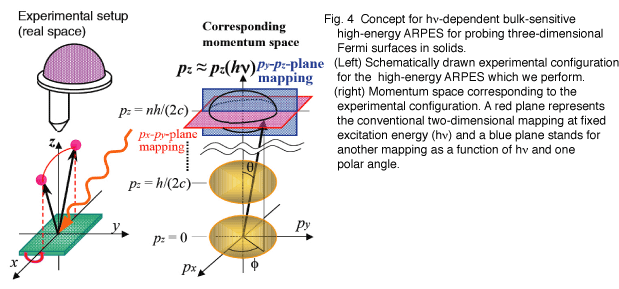
Bulk Fermi surfaces of CeRu2Ge2 at a "high" temperature
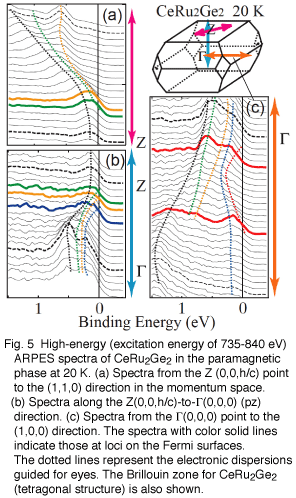 In rare-earth compounds, 4f electrons tend to be localized compared with the other orbital electrons due to strong Coulomb repulsive interaction (electron correlation) although the 4f electron energy is close to the Fermi level. Ce-based compounds with the 4f electron number of ~1 show variety of 4f states due to different hybridization between the 4f and valence electrons. For instance, CeRu2Si2 shows the heavy Fermion behavior with enormous effective electron mass enhancement [6]. On the other hand, CeRu2Ge2, which is isostructual to CeRu2Si2, undergoes a ferromagnetic transition at ~8 K for which the localized 4f electronic magnetic moment is responsible [7]. Although the Fermi surfaces of CeRu2Ge2 have been revealed at low temperatures in the magnetic phase by a quantum oscillation measurement [8], its electronic structures as well as the Fermi surfaces have not been clear in the paramagnetic phase above ~8 K. In order to reveal them, we have performed the high-energy ARPES for CeRu2Ge2 at a "high" temperature of 20 K.
In rare-earth compounds, 4f electrons tend to be localized compared with the other orbital electrons due to strong Coulomb repulsive interaction (electron correlation) although the 4f electron energy is close to the Fermi level. Ce-based compounds with the 4f electron number of ~1 show variety of 4f states due to different hybridization between the 4f and valence electrons. For instance, CeRu2Si2 shows the heavy Fermion behavior with enormous effective electron mass enhancement [6]. On the other hand, CeRu2Ge2, which is isostructual to CeRu2Si2, undergoes a ferromagnetic transition at ~8 K for which the localized 4f electronic magnetic moment is responsible [7]. Although the Fermi surfaces of CeRu2Ge2 have been revealed at low temperatures in the magnetic phase by a quantum oscillation measurement [8], its electronic structures as well as the Fermi surfaces have not been clear in the paramagnetic phase above ~8 K. In order to reveal them, we have performed the high-energy ARPES for CeRu2Ge2 at a "high" temperature of 20 K.
Figure 5 shows the high-energy ARPES spectra (EDCs) of CeRu2Ge2 in the paramagnetic phase. We can recognize that the energy positions of many peaks and shoulders in the spectra are changed depending on momentum. These peak energies as a function of momentum reflect the electronic dispersions. In addition, these structures change three-dimensionally in the momentum space, which is indication of the bulk electronic dispersions since the surface electrons are expected not to disperse along the pz direction in Fig. 5(b). From the ARPES measurements, we have obtained the cross-sections of the Fermi surfaces for CeRu2Ge2 at the high temperature (20 K) along the [110] and [001] planes including the Z (0,0,h/c) point in the momentum space as shown in Fig. 6. From these cross-sections, small and large ellipsoidal Fermi surfaces centered at the Z point, and small cylinder-like Fermi surfaces centered at the X (h/(2a),h/(2a),0), point are expected. Based on the high-energy ARPES results displayed here, we can obtain the qualitative shapes of the three-dimensional Fermi surfaces for CeRu2Ge2 in the paramagnetic phase as shown in Fig. 7. Although the ellipsoidal Fermi surfaces are similar to those in the magnetic phase [8] and in a theoretical result based on a localized 4f model [9], it is found that the cylinder Fermi surfaces are qualitatively different from those in the different phase and in the theoretical result.
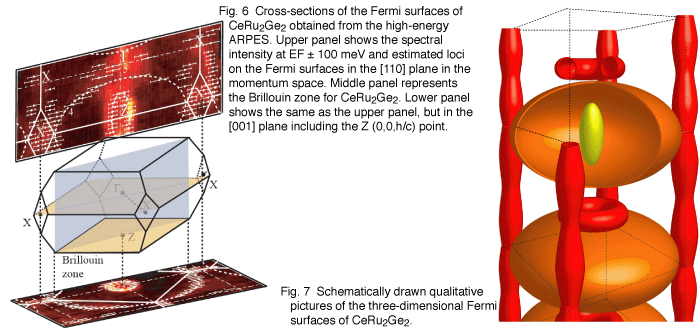
Outlook
We have developed the new technique for probing bulk three-dimensional electronic dispersions (structures) and Fermi surfaces by using high-energy APRES, which has been applied for the strongly correlated electron system CeRu2Ge2. To date, such quantum oscillation measurements as observation of de Haas-van Alphen effect are known as powerful tools to investigate the Fermi surfaces in solids although they require low temperatures as several K and almost detect-free high-quality stoichiometric single crystals. The high-energy ARPES can be applicable also for non-stoichiometric doped materials such as high-temperature superconductors even at high temperatures. We are convinced that the high-energy ARPES will become another complementary and powerful technique for probing the bulk Fermi surfaces in solids in near future.
References
[1] S. Huefner, "Photoelectron Spectroscopy" third edition, Springer, Belrin (2003).
[2] S. Tanuma, C. J. Powell and D. R. Penn, Surf. Sci 192, L849 (1987).
[3] A. Sekiyama et al., Phys. Rev. Lett. 93, 156402 (2004).
[4] Y. Saitoh et al., Rev. Sci. Instrum. 71, 3254 (2000).
[5] A. Sekiyama et al., Phys. Rev. B 70, 060506(R) (2004).
[6] H. Aoki et al., Phys. Rev. Lett. 71, 2110 (1993).
[7] M. J. Besnus et al., Physica B 171, 350 (1991).
[8] H. Ikezawa et al., Physica B 237, 210 (1997).
[9] H. Yamagami and A. Hasegawa, J. Phys. Soc. Jpn. 63, 2290 (1994).
- Akira Sekiyama


 Angle-resolved photoemission (ARPES) is known as a powerful tool to simultaneously detect the electronic dispersions (relations between the electron momentum and energy, namely, electronic structures) and the Fermi surfaces [1]. However, conventional low-excitation energy (hν ≲ 120 eV) ARPES mainly reflects the surface electronic states, which are often noticeably deviated from the bulk states for strongly correlated materials. Since the bulk electronic structures are responsible for the physical properties in solids, a technique for probing the bulk electronic structures is very important for studying solids. In order to overcome the surface sensitivity, high-excitation energy photoemission is promising due to the longer photoelectron escape depth [2] as shown in Fig. 1. Indeed, we have so far measured surface-sensitive low-energy and bulk-sensitive high-energy angle-integrated photoemission spectra reflecting the electron density of states in the solids for strongly correlated transition metal oxides Sr1-xCaxVO3 (Fig. 2), demonstrating the qualitative differences in the electronic states between the bulk and surface [3]. Here we show that the power of high-energy ARPES applied for a Ce-based strongly correlated material to clarify the bulk three-dimensional electronic structures and the Fermi surfaces.
Angle-resolved photoemission (ARPES) is known as a powerful tool to simultaneously detect the electronic dispersions (relations between the electron momentum and energy, namely, electronic structures) and the Fermi surfaces [1]. However, conventional low-excitation energy (hν ≲ 120 eV) ARPES mainly reflects the surface electronic states, which are often noticeably deviated from the bulk states for strongly correlated materials. Since the bulk electronic structures are responsible for the physical properties in solids, a technique for probing the bulk electronic structures is very important for studying solids. In order to overcome the surface sensitivity, high-excitation energy photoemission is promising due to the longer photoelectron escape depth [2] as shown in Fig. 1. Indeed, we have so far measured surface-sensitive low-energy and bulk-sensitive high-energy angle-integrated photoemission spectra reflecting the electron density of states in the solids for strongly correlated transition metal oxides Sr1-xCaxVO3 (Fig. 2), demonstrating the qualitative differences in the electronic states between the bulk and surface [3]. Here we show that the power of high-energy ARPES applied for a Ce-based strongly correlated material to clarify the bulk three-dimensional electronic structures and the Fermi surfaces. 


